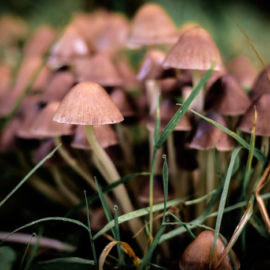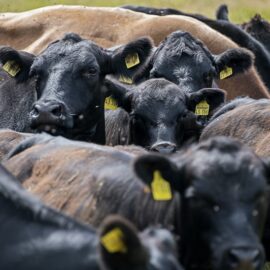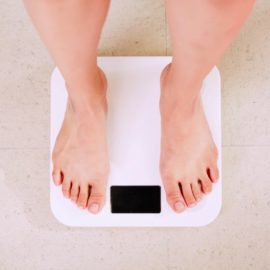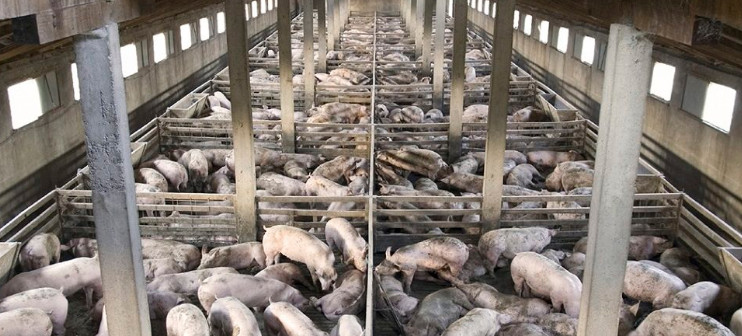
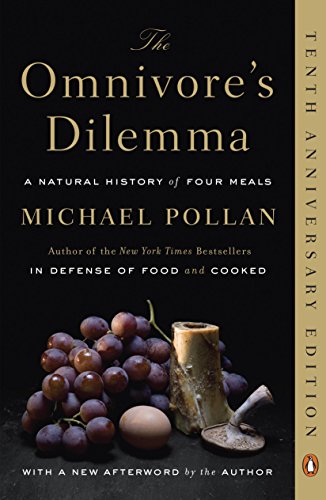
This article is an excerpt from the Shortform summary of "The Omnivore's Dilemma" by Michael Pollan. Shortform has the world's best summaries of books you should be reading.
Like this article? Sign up for a free trial here .
What are CAFOs in agriculture? What does CAFO stand for? Why are they bad for animals? Learn more about how massive-scale farms allow us to produce so much meat—but at a cost we should question.
What are CAFOs?
With the abundance of cheap corn, animals were moved from farm pastures to feedlots called CAFOs, Concentrated Animal Feeding Operations, where they could be fattened more quickly and efficiently.
One of the largest, Poky Feeders in Garden City, Kansas, shows how factory farms work. It features acres of pens containing 37,000 steers, eight miles of feed troughs, streams, and lagoons of waste, a processing plant, and a feed mill. The mill mixes feed for the cattle consisting of corn, liquified fat, protein, drugs, alfalfa, and silage.
This feed mix helps cattle, which are ruminants designed to eat grass, to eat corn without getting too sick. It isn’t good for them but it offers the cheapest calories, and there’s a huge supply.
Besides fattening animals efficiently, CAFOs have other economic advantages including:
- Consolidating animals in feedlots leaves more acreage for planting corn.
- The CAFO system has made meat cheap and abundant. Americans used to eat it just a few times a week, but now some eat meat multiple times a day.
- Also, corn-fed beef is marbled, which Americans like. (The USDA’s grading system is designed to reward marbling, and thus reward the feeding of corn to cows.)
Farms were once a closed ecological loop: You fed cattle waste products of crops, and fed manure from cattle back to the crops. Animal feedlots create two problems by breaking this loop: a need for chemical fertilizer, and a pollution problem. CAFOs produce air and water pollution, toxic waste, and deadly pathogens.
CAFO: From Grass to a Corn Diet
Beef cattle destined for CAFO feedlots are typically born on independent ranches in the West because of the large amount of land (10 acres) required to raise a calf. (By contrast, the pork and chicken industries have consolidated the animal’s entire life under one roof.)
Blair Ranch in Vale, South Dakota, a cow-calf operation on 5,500 acres of grass, is typical of how the system works. Ranches like this are the first stage in beef production.
Steers spend their first six months in pastures, eating grass as ruminants are designed to do. This is unlike feeding in CAFOs. Besides benefiting the cattle, grazing benefits the land by preventing the growth of trees and shrubs that block sunlight; the cattle spread grass seed and fertilize it with manure.
There’s some evidence that grazing makes ranges healthier, as long as cattle are moved frequently. The feedlot does greater environmental harm than grazing.
As ruminants, cattle convert grass to high quality protein through their rumen, a digestive organ that acts as a fermentation tank. They can make use of low-quality grasses.
But cows raised on grass take longer than those raised on corn to reach slaughter weight (4-5 years, compared to 14-16 months in corn-fed cows) — so it’s more efficient to feed them corn after a few months on grass at the start of their lives. Getting a steer from 80 to 1,100 pounds in 14 months in CAFOs takes huge quantities of corn, protein, and fat supplements, as well as drugs (particularly antibiotics).
After weaning at the ranch, calves are confined to a pen for a few months, where they learn to eat from a trough, and get accustomed to eating corn before being sent to a CAFO feedlot.
Since cows aren’t designed to digest corn, feeding them only corn leads to all sorts of problems.
- Feeding cattle a corn diet leads to bloat (a stomach gas buildup that can be fatal), acidosis that can be fatal, liver disease, and more problems. Up to 30 percent of feedlot cows have abscessed livers.
- Today beef cows are being bred/selected for their ability to eat large quantities of corn without getting too sick.
- Feedlots rely on antibiotics to keep cattle healthy enough to slaughter for food. In fact, most of the antibiotics sold in the U.S. end up in cattle feed, which is contributing to the development of superbugs.
The majority of cattle born on western ranches are funneled to four big meatpacking companies (Tyson/IBP, Cargill/Excel, Swith & Co., and National), which slaughter and market four of five beef cattle raised in the U.S.
Problems for Humans from Animal CAFOs
Concentrated Animal Feeding Operations lead to a bevy of problems for humans.
In the past, cows were fed a grisly meal – rendered cow parts and bonemeal. Due to the spread of mad cow disease, the FDA banned feeding cows rendered cow parts in 1997,but it could still be a problem. Rendered cattle meat and bonemeal are still being fed to chickens and pigs. It’s OK by the FDA to feed cows feather meal and chicken litter (bedding, feces, and discarded feed), as well as chicken, fish, and pig meal.
This means that when the cattle are fed chicken and pig meal, from animals that ate rendered cattle parts, infectious prions (the source of mad cow disease) could find their way back into cattle.
Besides the potential for mad cow disease, the industrial production of meat creates other health problems for humans. Corn-fed meat is less healthy for us: it contains more saturated fat and less healthy Omega-3 fatty acids than grass-fed meat.
———End of Preview———

Like what you just read? Read the rest of the world's best summary of Michael Pollan's "The Omnivore's Dilemma" at Shortform . Learn the book's critical concepts in 20 minutes or less .
Here's what you'll find in our full Omnivore's Dilemma summary :
- What does Omnivore's Dilemma mean?
- Why is industrial farming so bad for you and the environment?
- How did corn and its byproducts (like corn syrup) end up in tens of thousands of foods?
- How is Industrial Organic food like at Whole Foods not much better than massive industrial farming?
- What happens when you try to forage for your own food?

